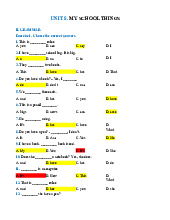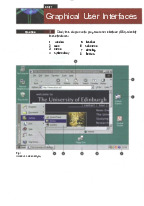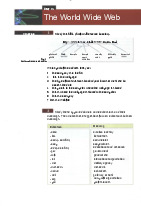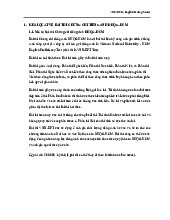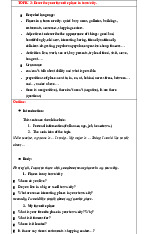





Preview text:
lOMoAR cPSD| 58968691
Why do people collect things?
People from almost every culture love collecting things. They might collect stamps, books, cards, priceless paintings
or worthless ticket stubs to old sports games. Their collection might hang on the walls of a mansion or be stored in a
box under the bed. So what is it that drives people to collect? Psychologist Dr Maria Richter argues that the urge to
collect is a basic human characteristic. According to her, in the very first years of life we form emotional connections
with lifeless objects such as soft toys. And these positive relationships are the starting point for our fascination with
collecting objects. In fact, the desire to collect may go back further still. Scientists suggest that for some ancient
humans living hundreds of thousands of years ago, collecting may have had a serious purpose. Only by collecting
sufficient food supplies to last through freezing winters or dry summers could our ancestors stay alive until the weather improved.
It turns out that even collecting for pleasure has a very long history. In 1925, the archaeologist Leonard Woolley was
working at a site in the historic Babylonian city of Ur. Woolley had travelled to the region intending only to excavate
the site of a palace. Instead, to his astonishment, he dug up artefacts which appeared to belong to a 2,500year-old
museum. Among the objects was part of a statue and a piece of a local building. And accompanying some of the
artefacts were descriptions like modern-day labels. These texts appeared in three languages and were carved into
pieces of clay. It seems likely that this early private collection of objects was created by Princess Ennigaldi, the
daughter of King Nabonidus. However, very little else is known about Princess Ennigaldi or what her motivations were
for setting up her collection.
Intend (v) – tend (v)- pretend(v)
To his Astonishing- out of the blue: su bat ngo Once in a blue moon
This may have been one of the first large private collections, but it was not the last. Indeed, the fashion for
establishing collections really got started in Europe around 2,000 years later with the so-called 'Cabinets of
Curiosities'. These were collections, usually belonging to wealthy families, that were displayed in cabinets or small rooms. Cabinets of Curiosities
included fine paintings and drawings, but equal importance typically was given to exhibits from
the natural world such as animal specimens, shells and plants. Only by + N/Ving /N phrase …,
[could/can/might/shall/should/does/ do] S+V
Under no circumstances ơcould/ might/sha] S+V
Under no circumstances should uou be absent for the English class.
Ko bao giờ có chuyện j đó
Some significant private collections of this sort date from the fifteenth century. One of the first belonged to the
Medici family. The Medicis became a powerful political family in Italy and later a royal house, but banking was
originally the source of all their wealth. The family started by collecting coins and valuable gems, then artworks and
antiques from around Europe. In 1570 a secret 'studio' was built inside the Palazzo Medici to house their growing
collection. This exhibition room had solid walls without windows to keep the valuable collection safe.
In the seventeenth century, another fabulous collection was created by a Danish physician named Ole Worm. His
collection room contained numerous skeletons and specimens, as well as ancient texts and a laboratory. One of Ole
Worm's motivations was to point out when other researchers had made mistakes, such as the false claim that birds
of paradise had no feet. He also owned a great auk, a species of bird that has now become extinct, and the illustration
he produced of it has been of value to later scientists.
The passion for collecting was just as strong in the nineteenth century. Lady Charlotte Guest spoke at least six
languages and became well-known for translating English books into Welsh. She also travelled widely throughout
Europe acquiring old and rare pottery, which she added to her collection at home in southern England. When Lady
Charlotte died in 1895 this collection was given to the Victoria and Albert Museum in London. At around the same lOMoAR cPSD| 58968691
time in the north of England, a wealthy goldsmith named Joseph Mayer was building up an enormous collection of
artefacts, particularly those dug up from sites in his local area. His legacy, the Mayer Trust, continues to fund public
lectures in accordance with his wishes.
In the twentieth century, the writer Beatrix Potter had a magnificent collection of books, insects, plants and other
botanical specimens. Most of these were donated to London's Natural History Museum, but Beatrix held on to her
cabinets of fossils, which she was particularly proud of. In the United States, President Franklin D. Roosevelt began
his stamp collection as a child and continued to add to it all his life. The stress associated with being president was
easier to cope with, Roosevelt said, by taking time out to focus on his collection. By the end of his life this had
expanded to include model ships, coins and artworks.
Most of us will never own collections so large or valuable as these. However, the examples given here suggest that
collecting is a passion that has been shared by countless people over many centuries.
Do the following statements agree with the information given in the passage? In boxes 1-6 on your answer sheet, write TRUE
If the statement agrees with the information FALSE
If the statement contradicts the information
NOT GIVEN If there is no information on this 1
Dr Maria Richter believes that people become interested in collecting in early childhood. 2
A form of collecting may have helped some ancient humans to survive. 3
Leonard Woolley expected to find the remains of a private collection at Ur. 4
Woolley found writing that identified some of the objects he discovered. 5
Princess Ennigaldi established her collection to show off her wealth. 6
Displaying artworks was the main purpose of Cabinets of Curiosities.
Complete the notes below.
Choose ONE WORD ONLY from the passage for each answer. Write your answers in boxes 713 on your answer sheet.
SOME SIGNIFICANT PRIVATE COLLECTIONS 15th-17th Centuries
• The Medici family made their money from 7 _____________.
• At the Palazzo Medici there was a hidden ‘studio’ which had no 8 _____________.
• Ole Worm liked to show when other scientists had made mistakes.
• Ole Worm made an important 9 _____________ of a bird.19th Century
• Lady Charlotte Guest created a collection of 10 _____________, which she left to a museum.
• Joseph Mayer paid for 11 _____________ that are still given to the public today.20th Century
• Beatrix Potter did not give away her collection of 12 _____________.
• Franklin D. Roosevelt believed collecting helped him deal with the 13 _____________ of hisjob. READING PASSAGE 1
You should spend about 20 minutes on Questions 1-13 which are based on Reading Passage 1 below.
Why we need to protect polar bears
Polar bears are being increasingly threatened by the effects of climate change, but their disappearance could have
far-reaching consequences. They are uniquely adapted to the extreme conditions of the Arctic Circle, where
temperatures can reach -40°C. One reason for this is that they have up to 11 centimetres of fat underneath their skin.
Humans with comparative levels of adipose tissue would be considered obese and would be likely to suffer from
diabetes and heart disease. Yet the polar bear experiences no such consequences. A 2014 study by Shi Ping Liu and
colleagues sheds light on this mystery. They compared the genetic structure of polar bears with that of their closest lOMoAR cPSD| 58968691
relatives from a warmer climate, the brown bears. This allowed them to determine the genes that have allowed polar
bears to survive in one of the toughest environments on Earth. Liu and his colleagues found the polar bears had a
gene known as APoB, which reduces levels of low-density lipoproteins (LDLs) – a form of ‘bad’ cholesterol. In humans,
mutations of this gene are associated with increased risk of heart disease. Polar bears may therefore be an important
study model to understand heart disease in humans.
The genome of the polar bear may also provide the solution for another condition, one that particularly affects our
older generation: osteoporosis. This is a disease where bones show reduced density, usually caused by insufficient
exercise, reduced calcium intake or food starvation. Bone tissue is constantly being remodelled, meaning that bone
is added or removed, depending on nutrient availability and the stress that the bone is under. Female polar bears,
however, undergo extreme conditions during every pregnancy. Once autumn comes around, these females will dig
maternity dens in the snow and will remain there throughout the winter, both before and after the birth of their cubs.
This process results in about six months of fasting, where the female bears have to keep themselves and their cubs
alive, depleting their own calcium and calorie reserves. Despite this, their bones remain strong and dense.
Physiologists Alanda Lennox and Allen Goodship found an explanation for this paradox in 2008. They discovered that
pregnant bears were able to increase the density of their bones before they started to build their dens. In addition,
six months later, when they finally emerged from the den with their cubs, there was no evidence of significant loss
of bone density. Hibernating brown bears do not have this capacity and must therefore resort to major bone
reformation in the following spring. If the mechanism of bone remodelling in polar bears can be understood, many
bedridden humans, and even astronauts, could potentially benefit.
The medical benefits of the polar bear for humanity certainly have their importance in our conservation efforts, but
these should not be the only factors taken into consideration. We tend to want to protect animals we think are
intelligent and possess emotions, such as elephants and primates. Bears, on the other hand, seem to be perceived
as stupid and in many cases violent. And yet anecdotal evidence from the field challenges those assumptions,
suggesting for example that polar bears have good problem-solving abilities. A male bear called GoGo in Tennoji Zoo,
Osaka, has even been observed making use of a tool to manipulate his environment. The bear used a tree branch on
multiple occasions to dislodge a piece of meat hung out of his reach. Problem-solving ability has also been witnessed
in wild polar bears, although not as obviously as with GoGo. A calculated move by a male bear involved running and
jumping onto barrels in an attempt to get to a photographer standing on a platform four metres high.
In other studies, such as one by Alison Ames in 2008, polar bears showed deliberate and focused manipulation. For
example, Ames observed bears putting objects in piles and then knocking them over in what appeared to be a game.
The study demonstrates that bears are capable of agile and thought-out behaviours. These examples suggest bears
have greater creativity and problem-solving abilities than previously thought.
As for emotions, while the evidence is once again anecdotal, many bears have been seen to hit out at ice and snow
– seemingly out of frustration – when they have just missed out on a kill. Moreover, polar bears can form unusual
relationships with other species, including playing with the dogs used to pull sleds in the Arctic. Remarkably, one
hand-raised polar bear called Agee has formed a close relationship with her owner Mark Dumas to the point where
they even swim together. This is even more astonishing since polar bears are known to actively hunt humans in the wild.
If climate change were to lead to their extinction, this would mean not only the loss of potential breakthroughs in
human medicine, but more importantly, the disappearance of an intelligent, majestic animal. lOMoAR cPSD| 58968691 Questions 1-7
Do the following statements agree with the information given in Reading Passage 1?
In boxes 1-7 on your answer sheet, write
TRUE if the statement agrees with the information
FALSE if the statement contradicts the information
NOT GIVEN if there is no information on this 1
Polar bears suffer from various health problems due to the build-up of fat under theirskin. 2
The study done by Liu and his colleagues compared different groups of polar bears.3 Liu and colleagues
were the first researchers to compare polar bears and brown bears genetically.
4 Polar bears are able to control their levels of ‘bad’ cholesterol by genetic means.
5 Female polar bears are able to survive for about six months without food.
6 It was found that the bones of female polar bears were very weak when they came out of their dens in spring.
7 The polar bear’s mechanism for increasing bone density could also be used by people one day. Questions 8-13 Complete the table below.
Choose ONE WORD ONLY from the passage for each answer. Write your answers in
boxes 8-13 on your answer sheet.
Reasons why polar bears should be protected People think of bears as
unintelligent and 8 ………………. .
However, this may not be correct. For example: ●
In Tennoji Zoo, a bear has been seen using a branch as a 9 ………………. . This allowed him to knock
down some 10 ………………. . ●
A wild polar bear worked out a method of reaching a platform wherea 11 ………………. was located. ●
Polar bears have displayed behaviour such as conscious manipulation of objects andactivity similar to
a 12 ………………. .
Bears may also display emotions. For example: ●
They may make movements suggesting 13 ………………. if disappointed when hunting. ●
They may form relationships with other species. READING PASSAGE 3
You should spend about 20 minutes on Questions 27-40 which are based on Reading Passage 3 below.
Chelsea Rochman, an ecologist at the University of California, Davis, has been trying to answer a dismal question: Is
everything terrible, or are things just very, very bad?
Rochman is a member of the National Center for Ecological Analysis and Synthesis’s marinedebris working group, a
collection of scientists who study, among other things, the growing problem of marine debris, also known as ocean
trash. Plenty of studies have sounded alarm bells about the state of marine debris; in a recent paper published in the
journal Ecology, Rochman and her colleagues set out to determine how many of those perceived risks are real.
Often, Rochman says, scientists will end a paper by speculating about the broader impacts of what they’ve found.
For example, a study could show that certain seabirds eat plastic bags, and go on to warn that whole bird populations
are at risk of dying out. ‘But the truth was that nobody had yet tested those perceived threats,’ Rochman says.
‘There wasn’t a lot of information.’
Rochman and her colleagues examined more than a hundred papers on the impacts of marine debris that were
published through 2013. Within each paper, they asked what threats scientists had studied – 366 perceived threats
in all – and what they’d actually found. lOMoAR cPSD| 58968691
In 83 percent of cases, the perceived dangers of ocean trash were proven true. In the remaining cases, the working
group found the studies had weaknesses in design and content which affected the validity of their conclusions – they
lacked a control group, for example, or used faulty statistics.
Strikingly, Rochman says, only one well-designed study failed to find the effect it was looking for, an investigation of
mussels ingesting microscopic bits. The plastic moved from the mussels’ stomachs to their bloodstreams, scientists
found, and stayed there for weeks – but didn’t seem to stress out the shellfish.
While mussels may be fine eating trash, though, the analysis also gave a clearer picture of the many ways that
ocean debris is bothersome.
Within the studies they looked at, most of the proven threats came from plastic debris, rather than other materials
like metal or wood. Most of the dangers also involved large pieces of debris – animals getting entangled in trash, for
example, or eating it and severely injuring themselves.
But a lot of ocean debris is ‘microplastic’, or pieces smaller than five millimeters. These may be ingredients used in
cosmetics and toiletries, fibers shed by synthetic clothing in the wash, or eroded remnants of larger debris. Compared
to the number of studies investigating largescale debris, Rochman’s group found little research on the effects of these
tiny bits. ‘There are a lot of open questions still for microplastic,’ Rochman says, though she notes that more papers
on the subject have been published since 2013, the cutoff point for the group’s analysis.
There are also, she adds, a lot of open questions about the ways that ocean debris can lead to sea-creature death.
Many studies have looked at how plastic affects an individual animal, or that animal’s tissues or cells, rather than
whole populations. And in the lab, scientists often use higher concentrations of plastic than what’s really in the ocean.
None of that tells us how many birds or fish or sea turtles could die from plastic pollution – or how deaths in one
species could affect that animal’s predators, or the rest of the ecosystem.
‘We need to be asking more ecologically relevant questions,’ Rochman says. Usually, scientists don’t know exactly
how disasters such as a tanker accidentally spilling its whole cargo of oil and polluting huge areas of the ocean will
affect the environment until after they’ve happened. ‘We don’t ask the right questions early enough,’ she says. But
if ecologists can understand how the slow-moving effect of ocean trash is damaging ecosystems, they might be able
to prevent things from getting worse.
Asking the right questions can help policy makers, and the public, figure out where to focus their attention. The
problems that look or sound most dramatic may not be the best places to start. For example, the name of the ‘Great
Pacific Garbage Patch’ – a collection of marine debris in the northern Pacific Ocean – might conjure up a vast, floating
trash island. In reality though, much of the debris is tiny or below the surface; a person could sail through the area
without seeing any trash at all. A Dutch group called ‘The Ocean Cleanup’ is currently working on plans to put
mechanical devices in the Pacific Garbage Patch and similar areas to suck up plastic. But a recent paper used
simulations to show that strategically positioning the cleanup devices closer to shore would more effectively reduce pollution over the long term.
‘I think clearing up some of these misperceptions is really important,’ Rochman says. Among scientists as well as in
the media, she says, ‘A lot of the images about strandings and entanglement and all of that cause the perception that
plastic debris is killing everything in the ocean.’ Interrogating the existing scientific literature can help ecologists figure
out which problems really need addressing, and which ones they’d be better off – like the mussels – absorbing and ignoring. Questions 27-33
Do the following statements agree with the information given in Reading Passage 3?
In boxes 27-33 on you answer sheet, write
TRUE if the statement agrees with the information
FALSE if the statement contradicts the information
NOT GIVEN if there is no information on this 27
Rochman and her colleagues were the first people to research the problem of marinedebris. 28
The creatures most in danger from ocean trash are certain seabirds. lOMoAR cPSD| 58968691 29
The studies Rochman has reviewed have already proved that populations of some birdswill soon become extinct. 30
Rochman analysed papers on the different kinds of danger caused by ocean trash. 31
Most of the research analysed by Rochman and her colleagues was badly designed.32 One study examined
by Rochman was expecting to find that mussels were harmed by eating plastic.
33 Some mussels choose to eat plastic in preference to their natural diet. Questions 34-39 Complete the notes below.
Choose ONE WORD ONLY from the passage for each answer.
Write your answers in boxes 34-39 on your answer sheet.
Findings related to marine debris
Studies of marine debris found the biggest threats were
• plastic (not metal or wood)
• bits of debris that were 34………………………….. (harmful to animals)
There was little research into 35…………………………. e.g. from synthetic fibres.
Drawbacks of the studies examined
• most of them focused on individual animals, not entire 36 ………………………..
• the 37…………………….. of plastic used in the lab did not always reflect those in the ocean
• there was insufficient information on
– numbers of animals which could be affected
– the impact of a reduction in numbers on the 38……………………….. of that species
– the impact on the ecosystem
Rochman says more information is needed on the possible impact of future 39………………………… (e.g. involving oil). Question 40
Choose the correct letter, A, B, C or D.
Write the correct letter in box 40 on your answer sheet.
40 What would be the best title for this passage? A
Assessing the threat of marine debris B Marine debris: who is to blame?
C A new solution to the problem of marine debris
D Marine debris: the need for international action
